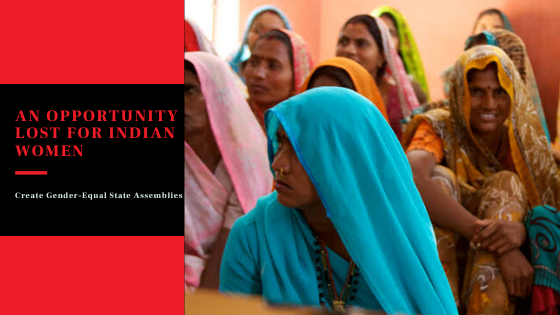An Opportunity Lost For Indian Women

As per final election commission data on Kerala electorate for 2016 assembly elections, Kerala voters comprised of 1,25,10,589 men and 1,35,08,693 women. In order to understand the importance of this data, it should be read along with a few national and international events with regard to women’s rights.
1) Sustainable development goals- adopted by countries including India through its goal number 5 envisages to achieve gender equality and empower all women and girls. It targets among many includes, and all forms of discrimination against all women and girls everywhere; ensure women’s full and effective participation and equal opportunities for leadership at all levels of
decision making in political, economic and public life; eliminate all forms of violence against all women and girls in the public and private spheres, including trafficking and sexual and other types of exploitation.
2) It was in December 2015 Saudi Arabia the only nation where women are not allowed to drive, gave its women the right to vote, making them caste their first votes in the country’s history, in municipal elections. Women were also standing as candidates, another first. A total of 978 women have registered as candidates, alongside 5,938 men. Officials said that About 130,000
women registered to vote. That figure still falls well short of male voter registration, which stands at 1.35 million. But still, it’s an achievement for the women of Saudi in this time of sustainable development goals which envisages achieving gender equality.
3) 2015 also saw Prime Minister Justin Trudeau named a young and ethnically diverse cabinet, with a ministerial team that for the first time in Canada’s history, equally balanced between men and women- 15 women and 15 men and are mostly aged under 50. Canadian voters elected 88 female MP’s, putting female representation in the House at 26 percent. And it won’t do much to improve Canada’s 50th-place ranking out of 190 countries on proportion of national-level female politicians, according to the Inter-Parliamentary Union, an international organization of parliaments – particularly since other countries have made much larger strides on this issue. For the first time in Canada’s history where women and girls comprise just over half of Canada’s population, all three main political parties had women in charge of their national campaigns.
It must be reiterated that even when women and girls comprised just over half of Canada’s population, they were not able to make their parliament gender-equal. they were not even able to achieve a 33-percentage representation for their women in parliament that the Indian women reservation bill envisages achieving.
Taking inspiration from the Canadian example is it possible to think beyond reservation in states where women voters are in majority and achieve where even Canada failed? The collective effort of women is what that is needed when women are in majority. Kerala assembly election witnessed a women voter majority situation with 1 crore 35 lakh plus women in majority over 1 crore 25 lakh plus men voters. This was a unique opportunity for women of our country to utilize this difference to attain 50 percent women representation in the state assembly. Kerala was one among the seven states/ UT’s which had female voter majority as per data from 2014 general election to Lok sabha. Even when many factors which include a large number of men from Kerala working abroad, which might have contributed for this huge difference, Kerala stands out as the state having the highest percentage of women voters in excess over their men voters. The international women’s day passed when our parliament was in session and by not even getting the women’s reservation bill passed. Reservation is of high need for women in states where women are in minority. But is it possible to think beyond reservation in states like Kerala where women voters are in majority?
Before talking about the golden opportunity our Indian women missed in achieving equal opportunity for women in political life, it should be specially mentioned that India ranks 143 in the world among 193 counties in the percentage of women as lawmakers in national parliaments as per data compiled by the Inter-Parliamentary Union. At this very same time in India, the president had requested the parliamentarians to pass the women reservation bill which envisages 1/3 seats to be reserved for women in both parliaments as well as state assemblies when countries like Rwanda already have more than 50 percent women representation.
The bill is still pending along with the government’s announcement that marital rape cannot be criminalized in India. What would be the reason for the parliament’s reluctance to legislate so as to give the married women of our country the right to their bodies?
According to census data, the child sex ratio (0-6 years) in India was 927 girls per 1,000 boys in 2001, which dropped drastically to 918 girls for every 1,000 boys in 2011. The Beti Bachao, Beti Padhao(BBBP) Scheme has been introduced in October, 2014 to address the issue of declining Child Sex Ratio(CSR). It could be said that the countries later Vedic attitude of giving preference to the male child still exist which undermines the importance of a girl child in this modern era. Currently, in majority states of India male voter population surpasses female voters and this CSR data guarantees the upper hand of men in electoral process of future elections too.
Unfortunately utilizing the very same women voter majority situation in Kerala, for the benefit of women was something difficult, as the women of the entire country did not unite beyond political ideologies so as to motivate women of Kerala to achieve a record 50 percent representation in the state assembly. It is worthy of imagination what all a political party established only for the cause of women could have achieved in this situation. The exception to Article 15 of the constitution does not put any restriction on the formation of such a political outfit for the upliftment of women. If this opportunity would have been utilized, it would have sent a
strong message to the women in other states of India, a message to protecting a girl child so as to achieve their basic rights collectively in a democracy by increasing the number of voices and thus sending their women representatives on par with men for achieving their rights through legislations without the help of reservations.
This overriding men voter numbers throughout the country could be the sole reason for the reluctance behind our major parliamentary parties in passing the woman reservation bill as well as criminalizing marital rape. So, this unique voter ratio which gave the woman of Indian State of Kerala an upper hand should have been utilized as an opportunity by prominent women of India for a gender-equal state assembly. This if achieved would have let the marginalized Indian woman from the rest of the country known the importance of an increased number of women as a means to democratically fighting for woman’s basic rights. It was an opportunity lost, to send a strong message across the globe that with an increased number of women, on par with men, along with collective efforts by women groups, could have achieved an equal representation for women in the democratic process without the help of reservations.
(Author: Stanley Xavier is an Assistant Professor of Management in Kerala)
Read our insights about diversity, legal updates and industry knowledge on workplace inclusion at Ungender Insights. Visit our Blog.
Sign up to stay up-to-date with our free e-mail newsletter.
The above insights are a product of our learning from our advisory work at Ungender. Our Team specialises in advising workplaces on gender centric laws.
or email us at contact@ungender.in




